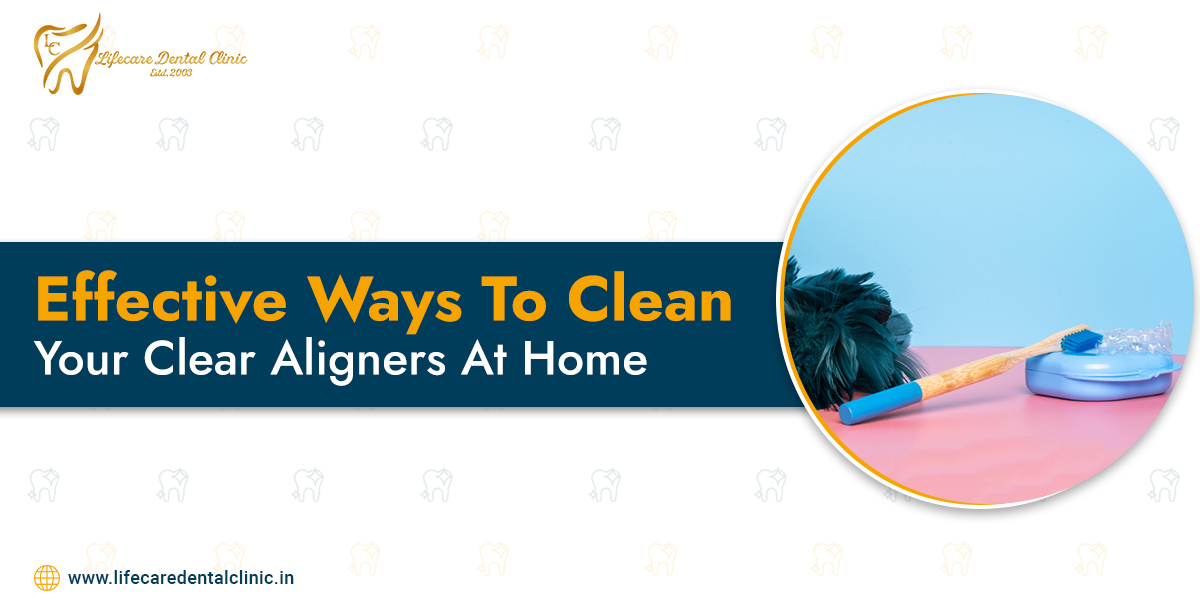Effective Ways To Clean Your Clear Aligners At Home

Published Date: June 18, 2024 Last Update: September 27, 2024
Author: Dr. Manpreet S. Walia
For many patients, clear aligners have become a game-changer in the world of orthodontics. These invisible trays work tirelessly to straighten your teeth, but just like your regular teeth, they need proper cleaning to maintain hygiene. Neglecting your aligner cleaning routine can lead to plaque build-up, bacteria, and even cause discoloration. But fear not, maintaining clean and clear aligners is a breeze with the right practices!
Read This Article - Transform Your Smile to Boost Your Confidence Through Clear Aligners
Here are Some Deep Cleaning Options
For a thorough clean, consider incorporating these methods into your routine:
1. Cleaning Tablets
These fizzy tablets dissolve in water, creating a solution that effectively removes plaque and bacteria. Follow the manufacturer's instructions for soaking time.
2. DIY Soaks
While not recommended every day, occasional soaks in a homemade solution can be refreshing. Here are two popular options:
-
White Vinegar and Water
Mix one tablespoon of white vinegar with lukewarm water. Soak your aligners for 15-20 minutes, then rinse thoroughly.
-
Baking Soda and Water
Create a paste with baking soda and water. Gently brush your aligners with the paste, then soak them in plain water for 30-60 minutes. Rinse thoroughly.
Remember
- Always rinse your clear aligners thoroughly after any cleaning method to remove any residual soap or solution.
- Store your aligners in their designated case whenever they're not in your mouth. This protects them from damage and keeps them clean.
- Never leave your aligners wrapped in a napkin or tissue. This can trap moisture and create a breeding ground for bacteria.
Bonus Tip
If you find your aligners develop a stubborn odor, even after cleaning, consult your dentist. They may recommend a stronger cleaning solution or have additional tips to keep your aligners fresh.
Daily Cleaning Do's and Don'ts
Do's
1. Rinse Before and After
Always rinse your aligners thoroughly with cold water before and after wearing them. This helps to remove any saliva or food particles, reducing the risk of bacterial buildup.
2. Invest in a soft-bristled toothbrush
Investing in a soft-bristled toothbrush to gently brush your aligners. This helps remove stubborn debris without scratching the plastic. Harsh brushing can scratch the surface, making it more prone to stains and bacterial accumulation.
3. Use Mild Soap
Clean your aligners with a mild soap or clear antibacterial detergent. Avoid using colored or scented soaps, as they may leave residues or cause discoloration
4. Soak Regularly
Soak your aligners regularly in a denture cleaner or specialized aligner cleaning solution. This helps to effectively remove stubborn stains and kill bacteria.
5. Keep Them Moist
When not wearing your aligners, store them in a clean, moist environment. Dry aligners can become brittle and prone to cracking.
6. Maintain Oral Hygiene
Continue to brush and floss your teeth regularly, even while wearing aligners. This helps to prevent plaque buildup and maintain overall oral health.
7. Consult Your Orthodontist
If you're unsure about the cleaning process or encounter any issues with your aligners, consult your orthodontist for guidance. They can provide personalized advice based on your specific needs.
Read This Article - Clear Aligners vs Traditional Braces – What’s Better For You?
Don'ts
1. Don't use hot water
Hot water can warp or deform the shape of your aligners, rendering them ineffective.
2. Use your regular toothpaste
Regular toothpaste contains abrasive ingredients that can scratch your aligners. Opt for a gentle, clear, non-whitening toothpaste or a mild, fragrance-free antibacterial soap or specialized cleaning solutions.
3. Skip the Dishwasher
Never clean your aligners in the dishwasher or with boiling water. The high heat and pressure can distort the shape of the aligners, rendering them ineffective.
4. Don't Eat or Drink with Aligners
Avoid eating or drinking (except water) while wearing your aligners. Food particles and beverages can get trapped between the aligner and your teeth, leading to bacterial growth and bad odor.
5. No Mouthwash Soaks
While mouthwash may seem like a good cleaning solution, it's not recommended for soaking aligners. Some mouthwashes contain alcohol or coloring agents that can damage the aligner material.
6. Avoid Staining Foods
Avoid dark-colored or strongly flavored foods and beverages, as they can stain your aligners. Examples include coffee, tea, red wine, and tomato & turmeric based sauces.
7. Don't Neglect Cleaning
Consistency is the key when it comes to aligner cleaning. Don't neglect this important step in your orthodontic care routine, as it can affect the clarity of your aligners and your overall oral health.
By following these simple do's and don'ts, you can ensure that your aligners remain clean, clear, and comfortable throughout your orthodontic treatment journey.
Conclusion
In conclusion, maintaining clean clear aligners is crucial for oral hygiene and treatment effectiveness. By incorporating the effective cleaning methods mentioned above into your daily routine, you can ensure that your clear aligners remain free from bacteria, plaque, and odors. Remember to brush and rinse them regularly, soak them in cleaning solutions as recommended by your orthodontist, and handle them with care to avoid damage. With proper care, your clear aligners will not only help you achieve a straighter smile but also contribute to your overall oral health and confidence throughout your orthodontic journey. Remember, a sparkling smile starts with sparkling clean aligners!

Leave A Reply